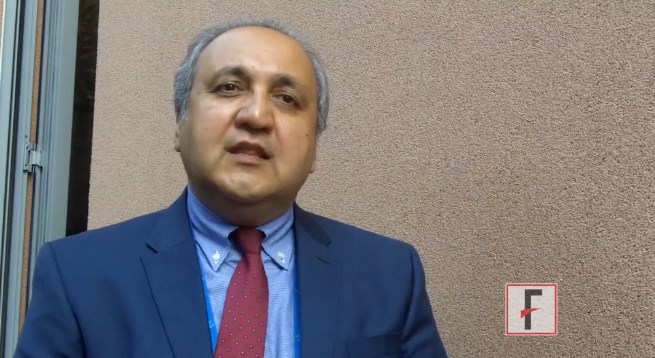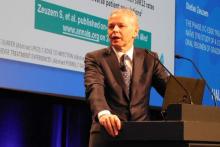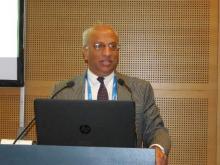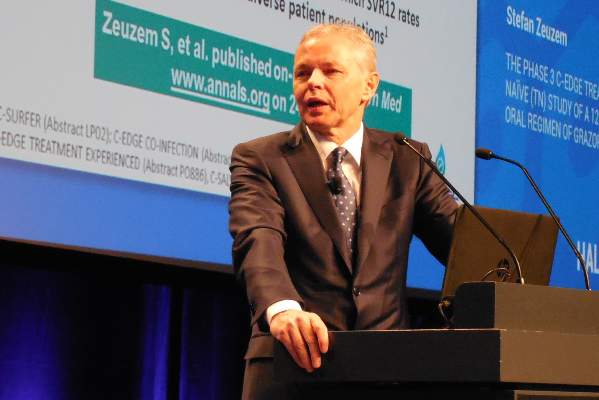User login
European Association for the Study of the Liver (EASL): International Liver Congress
VIDEO: NAFLD increasingly causing U.S. hepatocellular carcinomas
VIENNA – Nonalcoholic fatty liver disease (NAFLD) now stands as the second most common cause of U.S. cases of hepatocellular carcinoma, and with highly effective drug regimens now sharply dropping the prevalence of hepatitis C virus infection, NAFLD – a complication of obesity – is poised to snag the top spot, Dr. Zobair Younossi said in a video interview at the meeting sponsored by the European Association for the Study of the Liver.
In an analysis that combined U.S. national cancer registry data collected by the National Cancer Institute and morbidity diagnostic codes collected by Medicare, Dr. Younossi calculated that, during 2004-2009 among U.S. adults covered by Medicare, 24% of patients newly diagnosed with hepatocellular carcinoma (HCC) had NAFLD as their pre-existing chronic liver disease, compared with 48% who had hepatitis C virus infection as their trigger. The third most common cause of HCC was alcoholic liver disease (14%), followed by hepatitis B virus infection (8%).
Dr. Younossi’s analysis also included survival data for each HCC case in the first year following diagnosis, which showed that NAFLD-associated cases also were deadlier, linking with a statistically significant 20% increase in mortality compared with HCC associated with other causes. Quicker lethality of NAFLD-linked HCC is probably due to the more advanced stage at diagnosis, he said.
The findings highlight the need for improved surveillance in these patients, a process complicated by the challenge of imaging the liver in obese patients, said Dr. Younossi, chairman of medicine and head of the Center for Liver Diseases at Inova Fairfax Hospital in Falls Church, Va.
Dr. Younossi has been a consultant to Gilead, Abbvie, Bristol-Myers Squibb, GlaxoSmithKline, Intercept, and Salix.
The video associated with this article is no longer available on this site. Please view all of our videos on the MDedge YouTube channel
VIENNA – Nonalcoholic fatty liver disease (NAFLD) now stands as the second most common cause of U.S. cases of hepatocellular carcinoma, and with highly effective drug regimens now sharply dropping the prevalence of hepatitis C virus infection, NAFLD – a complication of obesity – is poised to snag the top spot, Dr. Zobair Younossi said in a video interview at the meeting sponsored by the European Association for the Study of the Liver.
In an analysis that combined U.S. national cancer registry data collected by the National Cancer Institute and morbidity diagnostic codes collected by Medicare, Dr. Younossi calculated that, during 2004-2009 among U.S. adults covered by Medicare, 24% of patients newly diagnosed with hepatocellular carcinoma (HCC) had NAFLD as their pre-existing chronic liver disease, compared with 48% who had hepatitis C virus infection as their trigger. The third most common cause of HCC was alcoholic liver disease (14%), followed by hepatitis B virus infection (8%).
Dr. Younossi’s analysis also included survival data for each HCC case in the first year following diagnosis, which showed that NAFLD-associated cases also were deadlier, linking with a statistically significant 20% increase in mortality compared with HCC associated with other causes. Quicker lethality of NAFLD-linked HCC is probably due to the more advanced stage at diagnosis, he said.
The findings highlight the need for improved surveillance in these patients, a process complicated by the challenge of imaging the liver in obese patients, said Dr. Younossi, chairman of medicine and head of the Center for Liver Diseases at Inova Fairfax Hospital in Falls Church, Va.
Dr. Younossi has been a consultant to Gilead, Abbvie, Bristol-Myers Squibb, GlaxoSmithKline, Intercept, and Salix.
The video associated with this article is no longer available on this site. Please view all of our videos on the MDedge YouTube channel
VIENNA – Nonalcoholic fatty liver disease (NAFLD) now stands as the second most common cause of U.S. cases of hepatocellular carcinoma, and with highly effective drug regimens now sharply dropping the prevalence of hepatitis C virus infection, NAFLD – a complication of obesity – is poised to snag the top spot, Dr. Zobair Younossi said in a video interview at the meeting sponsored by the European Association for the Study of the Liver.
In an analysis that combined U.S. national cancer registry data collected by the National Cancer Institute and morbidity diagnostic codes collected by Medicare, Dr. Younossi calculated that, during 2004-2009 among U.S. adults covered by Medicare, 24% of patients newly diagnosed with hepatocellular carcinoma (HCC) had NAFLD as their pre-existing chronic liver disease, compared with 48% who had hepatitis C virus infection as their trigger. The third most common cause of HCC was alcoholic liver disease (14%), followed by hepatitis B virus infection (8%).
Dr. Younossi’s analysis also included survival data for each HCC case in the first year following diagnosis, which showed that NAFLD-associated cases also were deadlier, linking with a statistically significant 20% increase in mortality compared with HCC associated with other causes. Quicker lethality of NAFLD-linked HCC is probably due to the more advanced stage at diagnosis, he said.
The findings highlight the need for improved surveillance in these patients, a process complicated by the challenge of imaging the liver in obese patients, said Dr. Younossi, chairman of medicine and head of the Center for Liver Diseases at Inova Fairfax Hospital in Falls Church, Va.
Dr. Younossi has been a consultant to Gilead, Abbvie, Bristol-Myers Squibb, GlaxoSmithKline, Intercept, and Salix.
The video associated with this article is no longer available on this site. Please view all of our videos on the MDedge YouTube channel
AT THE INTERNATIONAL LIVER CONGRESS 2015
Unrecognized Hepatitis C Linked With Advanced Hepatic Fibrosis
VIENNA – Roughly half of American adults with chronic hepatitis C infection are unaware of their infection, and about one-fifth of these people with unsuspected infection likely have advanced liver fibrosis, according to a new analysis of U.S. data.
These findings “strengthen the recommendation for hepatitis C virus (HCV) screening in asymptomatic individuals,” Dr. Prowpanga Udompap said at the meeting sponsored by the European Association for the Study of the Liver.
People infected by HCV with advanced liver fibrosis have top priority for receiving curative drug treatment, according to recommendations by the American Association for the Study of the Liver and the Infectious Diseases Society of America.
People who have HCV-associated liver fibrosis that goes untreated also risk having their infection become more refractory to cure over time, they risk progressive hepatic deterioration that will eventually become symptomatic, and they face increasing risk for developing liver cancer, noted Dr. W. Ray Kim, senior author of the study and professor of medicine and chief of gastroenterology and hepatology at Stanford (Calif.) University.
Dr. Kim said he was surprised that such a large percentage of Americans who have unrecognized HCV infection also probably have substantial hepatic damage.
“To me it’s alarming that 20% of people who are not aware of their HCV infection are treatment candidates. These people are out there, but not getting treated,” he said in an interview.
Current U.S. HCV screening recommendations from the Centers for Disease Control and Prevention call for screening all Americans born during 1945-1965, “but there is no incentive to screen” and many U.S. primary care physicians don’t have HCV screening on their radar, he said.
The analysis conducted by Dr. Udompap and Dr. Kim used data collected by the National Health and Nutrition Examination Survey during 2001-2012, when the National Center for Health Statistics administered HCV testing to 45,000 of the 62,000 individuals who participated in the survey during this period.
Of the 45,000 people tested, 420 (0.9%) screened antibody positive and had infection confirmed by a second, RNA-based test. The HCV positive patients then received a survey that included a question of whether they were aware of their HCV status before their current test result notification. One hundred sixty-three people (39%) completed and returned the survey: Eighty-three said they had previously been unaware they were HCV positive, and 80 said that they had known about their infection. The 50% rate of awareness of HCV chronic infection is consistent with a previously reported rate (Hepatology 2012;55:1652-61), said Dr. Udompap, a gastroenterology researcher at Stanford.
Individuals who were aware of their infection and those who were not had very similar demographic and clinical parameters. The average age was 53 years, and about two-thirds were men.
Dr. Udompap ran estimates of each respondent’s liver fibrosis and cirrhosis severity using the FIB-4 score and APRI score and data collected during the survey on age, liver enzyme levels, and platelet counts. These calculations showed that 22% of those ignorant of their HCV-positive status had a high probability of having advanced fibrosis, and 11% had a high probability of having cirrhosis, Dr. Udompap reported.
These rates tracked close to those of the people who knew about their HCV-positive status, of whom 15% had a high probability of having advanced liver fibrosis and 11% were highly likely to have cirrhosis.
Dr. Udompap reported having no financial disclosures. Dr. Kim has been a consultant to several drug companies that market, or are developing drugs, used to eradicate hepatitis C infections.
VIENNA – Roughly half of American adults with chronic hepatitis C infection are unaware of their infection, and about one-fifth of these people with unsuspected infection likely have advanced liver fibrosis, according to a new analysis of U.S. data.
These findings “strengthen the recommendation for hepatitis C virus (HCV) screening in asymptomatic individuals,” Dr. Prowpanga Udompap said at the meeting sponsored by the European Association for the Study of the Liver.
People infected by HCV with advanced liver fibrosis have top priority for receiving curative drug treatment, according to recommendations by the American Association for the Study of the Liver and the Infectious Diseases Society of America.
People who have HCV-associated liver fibrosis that goes untreated also risk having their infection become more refractory to cure over time, they risk progressive hepatic deterioration that will eventually become symptomatic, and they face increasing risk for developing liver cancer, noted Dr. W. Ray Kim, senior author of the study and professor of medicine and chief of gastroenterology and hepatology at Stanford (Calif.) University.
Dr. Kim said he was surprised that such a large percentage of Americans who have unrecognized HCV infection also probably have substantial hepatic damage.
“To me it’s alarming that 20% of people who are not aware of their HCV infection are treatment candidates. These people are out there, but not getting treated,” he said in an interview.
Current U.S. HCV screening recommendations from the Centers for Disease Control and Prevention call for screening all Americans born during 1945-1965, “but there is no incentive to screen” and many U.S. primary care physicians don’t have HCV screening on their radar, he said.
The analysis conducted by Dr. Udompap and Dr. Kim used data collected by the National Health and Nutrition Examination Survey during 2001-2012, when the National Center for Health Statistics administered HCV testing to 45,000 of the 62,000 individuals who participated in the survey during this period.
Of the 45,000 people tested, 420 (0.9%) screened antibody positive and had infection confirmed by a second, RNA-based test. The HCV positive patients then received a survey that included a question of whether they were aware of their HCV status before their current test result notification. One hundred sixty-three people (39%) completed and returned the survey: Eighty-three said they had previously been unaware they were HCV positive, and 80 said that they had known about their infection. The 50% rate of awareness of HCV chronic infection is consistent with a previously reported rate (Hepatology 2012;55:1652-61), said Dr. Udompap, a gastroenterology researcher at Stanford.
Individuals who were aware of their infection and those who were not had very similar demographic and clinical parameters. The average age was 53 years, and about two-thirds were men.
Dr. Udompap ran estimates of each respondent’s liver fibrosis and cirrhosis severity using the FIB-4 score and APRI score and data collected during the survey on age, liver enzyme levels, and platelet counts. These calculations showed that 22% of those ignorant of their HCV-positive status had a high probability of having advanced fibrosis, and 11% had a high probability of having cirrhosis, Dr. Udompap reported.
These rates tracked close to those of the people who knew about their HCV-positive status, of whom 15% had a high probability of having advanced liver fibrosis and 11% were highly likely to have cirrhosis.
Dr. Udompap reported having no financial disclosures. Dr. Kim has been a consultant to several drug companies that market, or are developing drugs, used to eradicate hepatitis C infections.
VIENNA – Roughly half of American adults with chronic hepatitis C infection are unaware of their infection, and about one-fifth of these people with unsuspected infection likely have advanced liver fibrosis, according to a new analysis of U.S. data.
These findings “strengthen the recommendation for hepatitis C virus (HCV) screening in asymptomatic individuals,” Dr. Prowpanga Udompap said at the meeting sponsored by the European Association for the Study of the Liver.
People infected by HCV with advanced liver fibrosis have top priority for receiving curative drug treatment, according to recommendations by the American Association for the Study of the Liver and the Infectious Diseases Society of America.
People who have HCV-associated liver fibrosis that goes untreated also risk having their infection become more refractory to cure over time, they risk progressive hepatic deterioration that will eventually become symptomatic, and they face increasing risk for developing liver cancer, noted Dr. W. Ray Kim, senior author of the study and professor of medicine and chief of gastroenterology and hepatology at Stanford (Calif.) University.
Dr. Kim said he was surprised that such a large percentage of Americans who have unrecognized HCV infection also probably have substantial hepatic damage.
“To me it’s alarming that 20% of people who are not aware of their HCV infection are treatment candidates. These people are out there, but not getting treated,” he said in an interview.
Current U.S. HCV screening recommendations from the Centers for Disease Control and Prevention call for screening all Americans born during 1945-1965, “but there is no incentive to screen” and many U.S. primary care physicians don’t have HCV screening on their radar, he said.
The analysis conducted by Dr. Udompap and Dr. Kim used data collected by the National Health and Nutrition Examination Survey during 2001-2012, when the National Center for Health Statistics administered HCV testing to 45,000 of the 62,000 individuals who participated in the survey during this period.
Of the 45,000 people tested, 420 (0.9%) screened antibody positive and had infection confirmed by a second, RNA-based test. The HCV positive patients then received a survey that included a question of whether they were aware of their HCV status before their current test result notification. One hundred sixty-three people (39%) completed and returned the survey: Eighty-three said they had previously been unaware they were HCV positive, and 80 said that they had known about their infection. The 50% rate of awareness of HCV chronic infection is consistent with a previously reported rate (Hepatology 2012;55:1652-61), said Dr. Udompap, a gastroenterology researcher at Stanford.
Individuals who were aware of their infection and those who were not had very similar demographic and clinical parameters. The average age was 53 years, and about two-thirds were men.
Dr. Udompap ran estimates of each respondent’s liver fibrosis and cirrhosis severity using the FIB-4 score and APRI score and data collected during the survey on age, liver enzyme levels, and platelet counts. These calculations showed that 22% of those ignorant of their HCV-positive status had a high probability of having advanced fibrosis, and 11% had a high probability of having cirrhosis, Dr. Udompap reported.
These rates tracked close to those of the people who knew about their HCV-positive status, of whom 15% had a high probability of having advanced liver fibrosis and 11% were highly likely to have cirrhosis.
Dr. Udompap reported having no financial disclosures. Dr. Kim has been a consultant to several drug companies that market, or are developing drugs, used to eradicate hepatitis C infections.
AT THE INTERNATIONAL LIVER CONGRESS 2015
ILC: Unrecognized hepatitis C linked with advanced hepatic fibrosis
VIENNA – Roughly half of American adults with chronic hepatitis C infection are unaware of their infection, and about one-fifth of these people with unsuspected infection likely have advanced liver fibrosis, according to a new analysis of U.S. data.
These findings “strengthen the recommendation for hepatitis C virus (HCV) screening in asymptomatic individuals,” Dr. Prowpanga Udompap said at the meeting sponsored by the European Association for the Study of the Liver.
People infected by HCV with advanced liver fibrosis have top priority for receiving curative drug treatment, according to recommendations by the American Association for the Study of the Liver and the Infectious Diseases Society of America.
People who have HCV-associated liver fibrosis that goes untreated also risk having their infection become more refractory to cure over time, they risk progressive hepatic deterioration that will eventually become symptomatic, and they face increasing risk for developing liver cancer, noted Dr. W. Ray Kim, senior author of the study and professor of medicine and chief of gastroenterology and hepatology at Stanford (Calif.) University.
Dr. Kim said he was surprised that such a large percentage of Americans who have unrecognized HCV infection also probably have substantial hepatic damage.
“To me it’s alarming that 20% of people who are not aware of their HCV infection are treatment candidates. These people are out there, but not getting treated,” he said in an interview.
Current U.S. HCV screening recommendations from the Centers for Disease Control and Prevention call for screening all Americans born during 1945-1965, “but there is no incentive to screen” and many U.S. primary care physicians don’t have HCV screening on their radar, he said.
The analysis conducted by Dr. Udompap and Dr. Kim used data collected by the National Health and Nutrition Examination Survey during 2001-2012, when the National Center for Health Statistics administered HCV testing to 45,000 of the 62,000 individuals who participated in the survey during this period.
Of the 45,000 people tested, 420 (0.9%) screened antibody positive and had infection confirmed by a second, RNA-based test. The HCV positive patients then received a survey that included a question of whether they were aware of their HCV status before their current test result notification. One hundred sixty-three people (39%) completed and returned the survey: Eighty-three said they had previously been unaware they were HCV positive, and 80 said that they had known about their infection. The 50% rate of awareness of HCV chronic infection is consistent with a previously reported rate (Hepatology 2012;55:1652-61), said Dr. Udompap, a gastroenterology researcher at Stanford.
Individuals who were aware of their infection and those who were not had very similar demographic and clinical parameters. The average age was 53 years, and about two-thirds were men.
Dr. Udompap ran estimates of each respondent’s liver fibrosis and cirrhosis severity using the FIB-4 score and APRI score and data collected during the survey on age, liver enzyme levels, and platelet counts. These calculations showed that 22% of those ignorant of their HCV-positive status had a high probability of having advanced fibrosis, and 11% had a high probability of having cirrhosis, Dr. Udompap reported.
These rates tracked close to those of the people who knew about their HCV-positive status, of whom 15% had a high probability of having advanced liver fibrosis and 11% were highly likely to have cirrhosis.
Dr. Udompap reported having no financial disclosures. Dr. Kim has been a consultant to several drug companies that market, or are developing drugs, used to eradicate hepatitis C infections.
On Twitter @mitchelzoler
VIENNA – Roughly half of American adults with chronic hepatitis C infection are unaware of their infection, and about one-fifth of these people with unsuspected infection likely have advanced liver fibrosis, according to a new analysis of U.S. data.
These findings “strengthen the recommendation for hepatitis C virus (HCV) screening in asymptomatic individuals,” Dr. Prowpanga Udompap said at the meeting sponsored by the European Association for the Study of the Liver.
People infected by HCV with advanced liver fibrosis have top priority for receiving curative drug treatment, according to recommendations by the American Association for the Study of the Liver and the Infectious Diseases Society of America.
People who have HCV-associated liver fibrosis that goes untreated also risk having their infection become more refractory to cure over time, they risk progressive hepatic deterioration that will eventually become symptomatic, and they face increasing risk for developing liver cancer, noted Dr. W. Ray Kim, senior author of the study and professor of medicine and chief of gastroenterology and hepatology at Stanford (Calif.) University.
Dr. Kim said he was surprised that such a large percentage of Americans who have unrecognized HCV infection also probably have substantial hepatic damage.
“To me it’s alarming that 20% of people who are not aware of their HCV infection are treatment candidates. These people are out there, but not getting treated,” he said in an interview.
Current U.S. HCV screening recommendations from the Centers for Disease Control and Prevention call for screening all Americans born during 1945-1965, “but there is no incentive to screen” and many U.S. primary care physicians don’t have HCV screening on their radar, he said.
The analysis conducted by Dr. Udompap and Dr. Kim used data collected by the National Health and Nutrition Examination Survey during 2001-2012, when the National Center for Health Statistics administered HCV testing to 45,000 of the 62,000 individuals who participated in the survey during this period.
Of the 45,000 people tested, 420 (0.9%) screened antibody positive and had infection confirmed by a second, RNA-based test. The HCV positive patients then received a survey that included a question of whether they were aware of their HCV status before their current test result notification. One hundred sixty-three people (39%) completed and returned the survey: Eighty-three said they had previously been unaware they were HCV positive, and 80 said that they had known about their infection. The 50% rate of awareness of HCV chronic infection is consistent with a previously reported rate (Hepatology 2012;55:1652-61), said Dr. Udompap, a gastroenterology researcher at Stanford.
Individuals who were aware of their infection and those who were not had very similar demographic and clinical parameters. The average age was 53 years, and about two-thirds were men.
Dr. Udompap ran estimates of each respondent’s liver fibrosis and cirrhosis severity using the FIB-4 score and APRI score and data collected during the survey on age, liver enzyme levels, and platelet counts. These calculations showed that 22% of those ignorant of their HCV-positive status had a high probability of having advanced fibrosis, and 11% had a high probability of having cirrhosis, Dr. Udompap reported.
These rates tracked close to those of the people who knew about their HCV-positive status, of whom 15% had a high probability of having advanced liver fibrosis and 11% were highly likely to have cirrhosis.
Dr. Udompap reported having no financial disclosures. Dr. Kim has been a consultant to several drug companies that market, or are developing drugs, used to eradicate hepatitis C infections.
On Twitter @mitchelzoler
VIENNA – Roughly half of American adults with chronic hepatitis C infection are unaware of their infection, and about one-fifth of these people with unsuspected infection likely have advanced liver fibrosis, according to a new analysis of U.S. data.
These findings “strengthen the recommendation for hepatitis C virus (HCV) screening in asymptomatic individuals,” Dr. Prowpanga Udompap said at the meeting sponsored by the European Association for the Study of the Liver.
People infected by HCV with advanced liver fibrosis have top priority for receiving curative drug treatment, according to recommendations by the American Association for the Study of the Liver and the Infectious Diseases Society of America.
People who have HCV-associated liver fibrosis that goes untreated also risk having their infection become more refractory to cure over time, they risk progressive hepatic deterioration that will eventually become symptomatic, and they face increasing risk for developing liver cancer, noted Dr. W. Ray Kim, senior author of the study and professor of medicine and chief of gastroenterology and hepatology at Stanford (Calif.) University.
Dr. Kim said he was surprised that such a large percentage of Americans who have unrecognized HCV infection also probably have substantial hepatic damage.
“To me it’s alarming that 20% of people who are not aware of their HCV infection are treatment candidates. These people are out there, but not getting treated,” he said in an interview.
Current U.S. HCV screening recommendations from the Centers for Disease Control and Prevention call for screening all Americans born during 1945-1965, “but there is no incentive to screen” and many U.S. primary care physicians don’t have HCV screening on their radar, he said.
The analysis conducted by Dr. Udompap and Dr. Kim used data collected by the National Health and Nutrition Examination Survey during 2001-2012, when the National Center for Health Statistics administered HCV testing to 45,000 of the 62,000 individuals who participated in the survey during this period.
Of the 45,000 people tested, 420 (0.9%) screened antibody positive and had infection confirmed by a second, RNA-based test. The HCV positive patients then received a survey that included a question of whether they were aware of their HCV status before their current test result notification. One hundred sixty-three people (39%) completed and returned the survey: Eighty-three said they had previously been unaware they were HCV positive, and 80 said that they had known about their infection. The 50% rate of awareness of HCV chronic infection is consistent with a previously reported rate (Hepatology 2012;55:1652-61), said Dr. Udompap, a gastroenterology researcher at Stanford.
Individuals who were aware of their infection and those who were not had very similar demographic and clinical parameters. The average age was 53 years, and about two-thirds were men.
Dr. Udompap ran estimates of each respondent’s liver fibrosis and cirrhosis severity using the FIB-4 score and APRI score and data collected during the survey on age, liver enzyme levels, and platelet counts. These calculations showed that 22% of those ignorant of their HCV-positive status had a high probability of having advanced fibrosis, and 11% had a high probability of having cirrhosis, Dr. Udompap reported.
These rates tracked close to those of the people who knew about their HCV-positive status, of whom 15% had a high probability of having advanced liver fibrosis and 11% were highly likely to have cirrhosis.
Dr. Udompap reported having no financial disclosures. Dr. Kim has been a consultant to several drug companies that market, or are developing drugs, used to eradicate hepatitis C infections.
On Twitter @mitchelzoler
AT THE INTERNATIONAL LIVER CONGRESS 2015
Key clinical point: One-fifth of Americans with unrecognized chronic hepatitis C infection likely have advanced hepatic fibrosis.
Major finding: Among U.S. adults with unrecognized chronic hepatitis C infection, 22% had laboratory results indicating a high probability of advanced hepatic fibrosis.
Data source: Data collected from 420 Americans found to have a chronic hepatitis C infection in the National Health and Nutrition Examination Survey during 2001-2012.
Disclosures: Dr. Udompap reported having no financial disclosures. Dr. Kim has been a consultant to several drug companies that market or develop drugs to eradicate hepatitis C infections.
ILC: New single daily pill eradicates hepatitis C
VIENNA – A new, once-daily, single-pill regimen for treating chronic hepatitis C infection without interferon or ribavirin showed 95% eradication efficacy after 12 weeks of safe treatment in a pivotal trial with 421 treatment-naive patients.
The study results also showed that the combination of grazoprevir and elbasvir, drugs that target two different hepatitis C proteins, was equally effective in noncirrhotic and compensated cirrhotic patents. Although more than 90% of the enrolled patients were infected by genotype 1 hepatitis C, the new combination also showed efficacy in the small number of patients enrolled who were infected by either genotype 4 or genotype 6 virus.
Perhaps the most important consequence of the new study, the C-EDGE trial, is that it put the grazoprevir-elbasvir combination on track for near-term approval as another simple, effective, interferon- and ribavirin-free regimen to cure patients of chronic hepatitis C infection, a step that would sharpen competition in this niche and could lead to price reductions among the currently available, high-cost treatments.
“I love competition,” said Dr. Stefan Zeuzem as he reported the results at the meeting, which was sponsored by the European Association for the Study of the Liver. “We should have many regimens that produce excellent sustained virologic response because we see in the data that certain drug combinations fit better for special indications,” said Dr. Zeuzem, professor and chief of medicine at J.W. Goethe University Hospital in Frankfurt, Germany.
“This provides an excellent option, and we need more options” for treating chronic hepatitis C, said Dr. K. Rajender Reddy, a coauthor with Dr. Zeuzem on the study and professor and director of hepatology at the University of Pennsylvania in Philadelphia.
“It’s one pill, it works in more than 90% of patients, the side effect profile is good,” and the grazoprevir-elbasvir combination can be used in patients with severe renal impairment and a glomerular filtration rate below 30 mL/min per 1.73 m2, something not recommended with one of the major drugs now available for treating hepatitis C, sofosbuvir (Sovaldi and Harvoni), Dr. Reddy said in an interview.
And it’s a “huge step” toward simpler hepatitis C–treatment regimens that are applicable to a broader range of patients, commented Dr. Donald M. Jensen, a hepatologist in Oak Park, Ill. who helped develop hepatitis C–treatment recommendations for the American Association for the Study of Liver Diseases.
“It offers the ability to treat multiple genotypes and had a high success rate, but it still relies on a protease inhibitor so it will still have issues of drug-drug interactions,” Dr. Jensen said in an interview. “Hopefully, as more regimens come out, companies will have to price their regimens competitively.”
The C-EDGE trial randomized 316 patients to immediate treatment with the grazoprevir-elbasvir combination and 105 patients to 4 weeks of placebo treatment as controls for adverse-effect monitoring, after which they also began active treatment. The trial enrolled patients during June 2014-March 2015 at 60 centers in nine countries. The rate of sustained virologic response after 12 weeks, the study’s primary endpoint, occurred in 92% of patients infected with genotype 1a, 99% of those infected by 1b, 100% of the 18 patients infected by genotype 4, and in 8 of the 10 patients infected by genotype 6, Dr. Zeuzem reported.
Concurrent with his talk at the meeting on April 24, the results were published online (Ann. Int. Med. 2015 [doi:10.7326/M15-0785]).
“You can use this regimen comfortably for genotype 4. Whether you want to take the data seriously for genotype 6 is a question,” noted Dr. Reddy, who acknowledged that the 10-patient experience for genotype 6 is too preliminary to provide firm guidance on efficacy. The apparent efficacy of the grazoprevir-elbasvir combination beyond genotype 1 reflects the fact that both drugs are “second generation” agents, particularly designed to have pan-genotype efficacy, Dr. Reddy said.
The safety profile of the two drugs was encouraging, with adverse events occurring at rates no different than in the placebo arm. No patient had a serious adverse event on active treatment, and two patients in the active arm discontinued because of an adverse event.
The data also showed that the regimen was effective regardless of age, sex, race, or the presence of compensated cirrhosis. All of the virologic failures occurred in patients with high viral loads – greater than 800,000 IU/mL – when they started treatment, a finding consistent with prior reports, Dr. Zeuzem said. The patients who had virologic failure carried resistance-associated variant strains of hepatitis C.
The C-EDGE trial was sponsored by Merck, which is developing the drugs used in the study. Dr. Zeuzem has been a consultant for and speaker on behalf of Merck and for AbbVie, Bristol-Myers Squibb, Gilead, and Janssen. Dr. Reddy has been a consultant to and received research support from Merck and Bristol-Myers Squibb, AbbVie, Janssen, and Gilead, Dr. Jensen had no disclosures.
VIENNA – A new, once-daily, single-pill regimen for treating chronic hepatitis C infection without interferon or ribavirin showed 95% eradication efficacy after 12 weeks of safe treatment in a pivotal trial with 421 treatment-naive patients.
The study results also showed that the combination of grazoprevir and elbasvir, drugs that target two different hepatitis C proteins, was equally effective in noncirrhotic and compensated cirrhotic patents. Although more than 90% of the enrolled patients were infected by genotype 1 hepatitis C, the new combination also showed efficacy in the small number of patients enrolled who were infected by either genotype 4 or genotype 6 virus.
Perhaps the most important consequence of the new study, the C-EDGE trial, is that it put the grazoprevir-elbasvir combination on track for near-term approval as another simple, effective, interferon- and ribavirin-free regimen to cure patients of chronic hepatitis C infection, a step that would sharpen competition in this niche and could lead to price reductions among the currently available, high-cost treatments.
“I love competition,” said Dr. Stefan Zeuzem as he reported the results at the meeting, which was sponsored by the European Association for the Study of the Liver. “We should have many regimens that produce excellent sustained virologic response because we see in the data that certain drug combinations fit better for special indications,” said Dr. Zeuzem, professor and chief of medicine at J.W. Goethe University Hospital in Frankfurt, Germany.
“This provides an excellent option, and we need more options” for treating chronic hepatitis C, said Dr. K. Rajender Reddy, a coauthor with Dr. Zeuzem on the study and professor and director of hepatology at the University of Pennsylvania in Philadelphia.
“It’s one pill, it works in more than 90% of patients, the side effect profile is good,” and the grazoprevir-elbasvir combination can be used in patients with severe renal impairment and a glomerular filtration rate below 30 mL/min per 1.73 m2, something not recommended with one of the major drugs now available for treating hepatitis C, sofosbuvir (Sovaldi and Harvoni), Dr. Reddy said in an interview.
And it’s a “huge step” toward simpler hepatitis C–treatment regimens that are applicable to a broader range of patients, commented Dr. Donald M. Jensen, a hepatologist in Oak Park, Ill. who helped develop hepatitis C–treatment recommendations for the American Association for the Study of Liver Diseases.
“It offers the ability to treat multiple genotypes and had a high success rate, but it still relies on a protease inhibitor so it will still have issues of drug-drug interactions,” Dr. Jensen said in an interview. “Hopefully, as more regimens come out, companies will have to price their regimens competitively.”
The C-EDGE trial randomized 316 patients to immediate treatment with the grazoprevir-elbasvir combination and 105 patients to 4 weeks of placebo treatment as controls for adverse-effect monitoring, after which they also began active treatment. The trial enrolled patients during June 2014-March 2015 at 60 centers in nine countries. The rate of sustained virologic response after 12 weeks, the study’s primary endpoint, occurred in 92% of patients infected with genotype 1a, 99% of those infected by 1b, 100% of the 18 patients infected by genotype 4, and in 8 of the 10 patients infected by genotype 6, Dr. Zeuzem reported.
Concurrent with his talk at the meeting on April 24, the results were published online (Ann. Int. Med. 2015 [doi:10.7326/M15-0785]).
“You can use this regimen comfortably for genotype 4. Whether you want to take the data seriously for genotype 6 is a question,” noted Dr. Reddy, who acknowledged that the 10-patient experience for genotype 6 is too preliminary to provide firm guidance on efficacy. The apparent efficacy of the grazoprevir-elbasvir combination beyond genotype 1 reflects the fact that both drugs are “second generation” agents, particularly designed to have pan-genotype efficacy, Dr. Reddy said.
The safety profile of the two drugs was encouraging, with adverse events occurring at rates no different than in the placebo arm. No patient had a serious adverse event on active treatment, and two patients in the active arm discontinued because of an adverse event.
The data also showed that the regimen was effective regardless of age, sex, race, or the presence of compensated cirrhosis. All of the virologic failures occurred in patients with high viral loads – greater than 800,000 IU/mL – when they started treatment, a finding consistent with prior reports, Dr. Zeuzem said. The patients who had virologic failure carried resistance-associated variant strains of hepatitis C.
The C-EDGE trial was sponsored by Merck, which is developing the drugs used in the study. Dr. Zeuzem has been a consultant for and speaker on behalf of Merck and for AbbVie, Bristol-Myers Squibb, Gilead, and Janssen. Dr. Reddy has been a consultant to and received research support from Merck and Bristol-Myers Squibb, AbbVie, Janssen, and Gilead, Dr. Jensen had no disclosures.
VIENNA – A new, once-daily, single-pill regimen for treating chronic hepatitis C infection without interferon or ribavirin showed 95% eradication efficacy after 12 weeks of safe treatment in a pivotal trial with 421 treatment-naive patients.
The study results also showed that the combination of grazoprevir and elbasvir, drugs that target two different hepatitis C proteins, was equally effective in noncirrhotic and compensated cirrhotic patents. Although more than 90% of the enrolled patients were infected by genotype 1 hepatitis C, the new combination also showed efficacy in the small number of patients enrolled who were infected by either genotype 4 or genotype 6 virus.
Perhaps the most important consequence of the new study, the C-EDGE trial, is that it put the grazoprevir-elbasvir combination on track for near-term approval as another simple, effective, interferon- and ribavirin-free regimen to cure patients of chronic hepatitis C infection, a step that would sharpen competition in this niche and could lead to price reductions among the currently available, high-cost treatments.
“I love competition,” said Dr. Stefan Zeuzem as he reported the results at the meeting, which was sponsored by the European Association for the Study of the Liver. “We should have many regimens that produce excellent sustained virologic response because we see in the data that certain drug combinations fit better for special indications,” said Dr. Zeuzem, professor and chief of medicine at J.W. Goethe University Hospital in Frankfurt, Germany.
“This provides an excellent option, and we need more options” for treating chronic hepatitis C, said Dr. K. Rajender Reddy, a coauthor with Dr. Zeuzem on the study and professor and director of hepatology at the University of Pennsylvania in Philadelphia.
“It’s one pill, it works in more than 90% of patients, the side effect profile is good,” and the grazoprevir-elbasvir combination can be used in patients with severe renal impairment and a glomerular filtration rate below 30 mL/min per 1.73 m2, something not recommended with one of the major drugs now available for treating hepatitis C, sofosbuvir (Sovaldi and Harvoni), Dr. Reddy said in an interview.
And it’s a “huge step” toward simpler hepatitis C–treatment regimens that are applicable to a broader range of patients, commented Dr. Donald M. Jensen, a hepatologist in Oak Park, Ill. who helped develop hepatitis C–treatment recommendations for the American Association for the Study of Liver Diseases.
“It offers the ability to treat multiple genotypes and had a high success rate, but it still relies on a protease inhibitor so it will still have issues of drug-drug interactions,” Dr. Jensen said in an interview. “Hopefully, as more regimens come out, companies will have to price their regimens competitively.”
The C-EDGE trial randomized 316 patients to immediate treatment with the grazoprevir-elbasvir combination and 105 patients to 4 weeks of placebo treatment as controls for adverse-effect monitoring, after which they also began active treatment. The trial enrolled patients during June 2014-March 2015 at 60 centers in nine countries. The rate of sustained virologic response after 12 weeks, the study’s primary endpoint, occurred in 92% of patients infected with genotype 1a, 99% of those infected by 1b, 100% of the 18 patients infected by genotype 4, and in 8 of the 10 patients infected by genotype 6, Dr. Zeuzem reported.
Concurrent with his talk at the meeting on April 24, the results were published online (Ann. Int. Med. 2015 [doi:10.7326/M15-0785]).
“You can use this regimen comfortably for genotype 4. Whether you want to take the data seriously for genotype 6 is a question,” noted Dr. Reddy, who acknowledged that the 10-patient experience for genotype 6 is too preliminary to provide firm guidance on efficacy. The apparent efficacy of the grazoprevir-elbasvir combination beyond genotype 1 reflects the fact that both drugs are “second generation” agents, particularly designed to have pan-genotype efficacy, Dr. Reddy said.
The safety profile of the two drugs was encouraging, with adverse events occurring at rates no different than in the placebo arm. No patient had a serious adverse event on active treatment, and two patients in the active arm discontinued because of an adverse event.
The data also showed that the regimen was effective regardless of age, sex, race, or the presence of compensated cirrhosis. All of the virologic failures occurred in patients with high viral loads – greater than 800,000 IU/mL – when they started treatment, a finding consistent with prior reports, Dr. Zeuzem said. The patients who had virologic failure carried resistance-associated variant strains of hepatitis C.
The C-EDGE trial was sponsored by Merck, which is developing the drugs used in the study. Dr. Zeuzem has been a consultant for and speaker on behalf of Merck and for AbbVie, Bristol-Myers Squibb, Gilead, and Janssen. Dr. Reddy has been a consultant to and received research support from Merck and Bristol-Myers Squibb, AbbVie, Janssen, and Gilead, Dr. Jensen had no disclosures.
AT THE INTERNATIONAL LIVER CONGRESS 2015
Key clinical point: Once-daily, single-pill combination treatment with grazoprevir and elbasvir for 12 weeks was safe and effective for eradicating chronic hepatitis C infection.
Major finding: Twelve weeks of treatment produced a sustained virologic response in 95% of patients.
Data source: The C-EDGE trial, which enrolled 421 treatment-naive patients with chronic hepatitis C infection at 60 centers in nine countries.
Disclosures: The C-EDGE trial was sponsored by Merck, which is developing the drugs used in the study. Dr. Zeuzem has been a consultant for and speaker on behalf of Merck and for AbbVie, Bristol-Myers Squibb, Gilead, and Janssen. Dr. Reddy has been a consultant to and received research support from Merck and Bristol-Myers Squibb, AbbVie, Janssen, and Gilead, Dr. Jensen had no disclosures.












